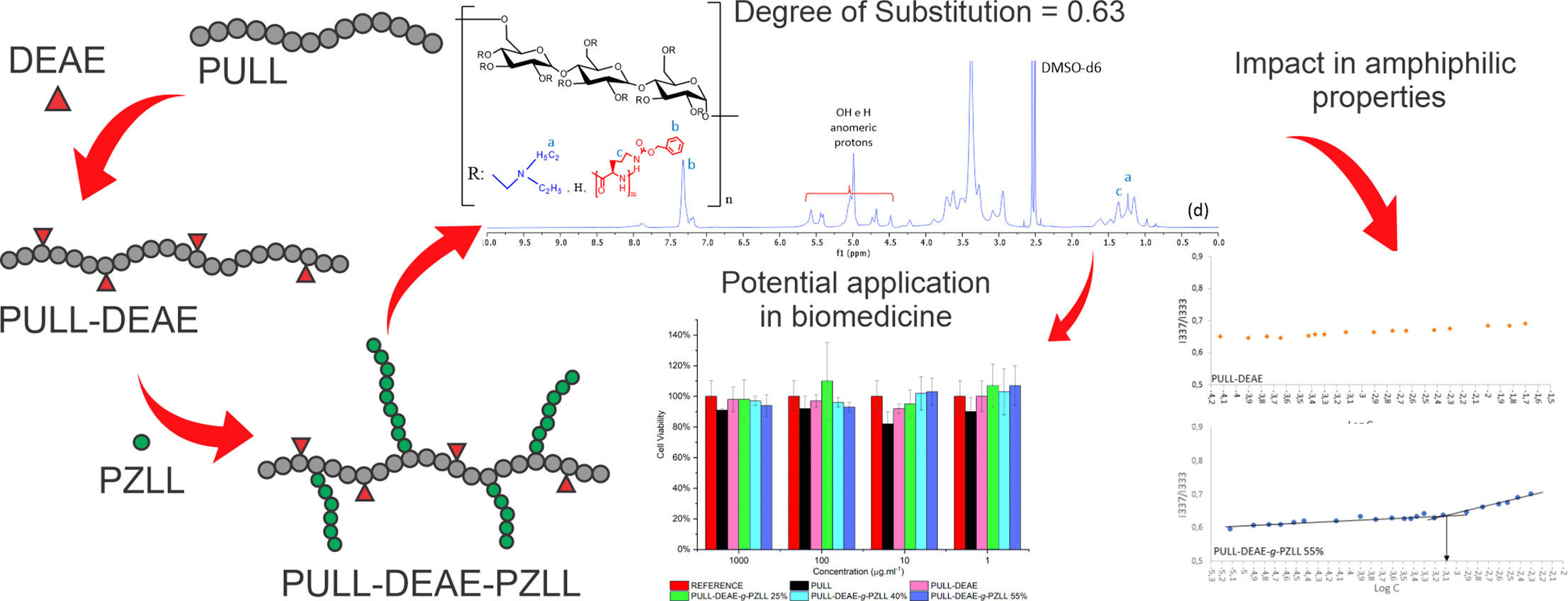Preparation and characterization of cationic pullulan-based polymers with hydrophilic or amphiphilic characteristics for drug delivery

Pullulan has attracted considerable attention due to its immunogenicity, biodegradability, biocompatibility, and hydrophilic nature, making it useful in cosmetics and pharmaceutical applications. In addition, pullulan is considered a biopolymer capable of modification via chemical reactions, which is a promising strategy to expand the range of its applications. In this study, cationic pullulan-based polymers with hydrophilic or amphiphilic nature were successfully synthesized by nucleophilic replacement and ring-opening polymerization.
Highlights
- Chemical modification of PULL to obtain hydrophilic cationic polymer (PULL-DEAE).
- Synthesis of amphiphilic copolymer of PULL-DEAE-PZLL with different PZLL amount.
- Evaluation of physical and chemical properties by NMR, FTIR, DSC, TGA, and XRD.
- Investigation of the hydrophilic and amphiphilic properties by CAC.
- Ascertainment of the biocompatibility with cytotoxicity test.
Firstly, pullulan was partially modified with 2-Chloro-N,N-diethylethylamine (DEAE) to generate DEAE-modified pullulan (PULL-DEAE), a polymer with cationic and hydrophilic nature. Secondly, the remaining hydroxyl groups of PULL-DEAE were reacted with N-carbobenzyloxy-l-lysine N-carboxyanhydride (Lys(Z)-NCA), producing the grafted copolymer pullulan-DEAE-g-poly(Z–l-lysine) (PULL-DEAE-g-PZLL), a copolymer with cationic and amphiphilic properties. For the copolymerizations, different monomer concentrations (25, 40, and 55% w/w, relating to pullulan) were used, resulting in three copolymers with different sizes of hydrophobic segments. All polymers were characterized in terms of chemical composition, molar mass, thermal properties, critical aggregation concentration, and cytotoxicity. NMR confirmed the graft copolymerization, and the degree of substitution obtained for each copolymer was 0.13, 0.54, and 0.63, respectively. The results suggest that the physicochemical properties of both pullulan-based cationic derivatives (PULL-DEAE and PULL-DEAE-g-PZLL) could expand the application of modified pullulan for pharmaceutical fields such as drug delivery.
Read more
Layde T. Carvalho, Ana Julia R.M. Teixeira, Rodolfo M. Moraes, Rennan F.S. Barbosa, Rafaela C. Queiroz, Dayane B. Tada, Daniella R. Mulinari, Derval S. Rosa, Maria Inês Ré, Simone F. Medeiros, Preparation and characterization of cationic pullulan-based polymers with hydrophilic or amphiphilic characteristics for drug delivery, Reactive and Functional Polymers, Volume 181, 2022, 105441, ISSN 1381-5148,
https://doi.org/10.1016/j.reactfunctpolym.2022.105441.

